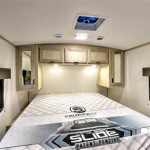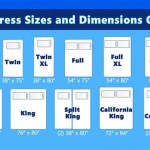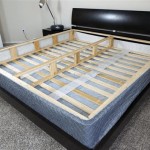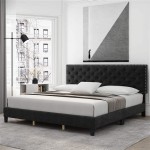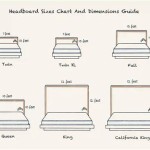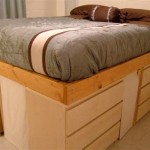Plans For A Full-Size Bed: A Comprehensive Guide
Constructing a full-size bed frame is a rewarding project that can result in a customized piece of furniture tailored to specific needs and aesthetic preferences. The undertaking requires careful planning, accurate measurements, and a selection of appropriate materials. This article provides a detailed guide to developing plans for a full-size bed, covering essential considerations, design options, and crucial steps for a successful build.
A full-size bed, also known as a double bed, typically measures 54 inches in width and 75 inches in length. These dimensions serve as the foundation for all planning decisions. However, the overall size of the bed frame will exceed these measurements to accommodate the mattress and any desired decorative elements. The specific increase in dimensions depends on the chosen design and construction methods. Before initiating the planning process, understanding the space limitations of the bedroom is paramount. The bed should fit comfortably within the room, allowing for adequate space for movement and other furniture.
The selection of materials is a critical factor that influences the bed’s durability, aesthetic appeal, and overall cost. Wood is a popular choice for bed frames due to its strength, workability, and aesthetic versatility. Commonly used wood species include pine, oak, maple, and walnut. Pine is a cost-effective option, while oak, maple, and walnut offer enhanced durability and visual appeal. Metal frames are another viable option, particularly for individuals seeking a modern or industrial aesthetic. Metal frames are known for their strength and longevity but may require specialized tools and welding skills for construction. The choice of hardware, such as screws, bolts, and brackets, is equally important. High-quality hardware ensures the structural integrity of the bed frame and prevents premature failure.
Key Point 1: Determining Bed Frame Style and Design
The style and design of the bed frame significantly impact the overall aesthetic of the bedroom. Numerous design options are available, ranging from simple platform beds to more elaborate designs with headboards, footboards, and side rails. A platform bed typically consists of a simple frame with a solid or slatted surface to support the mattress. This design is minimalist and cost-effective, suitable for modern or contemporary spaces. Alternatively, a bed frame with a headboard and footboard provides additional support and visual interest. The design of the headboard and footboard can vary widely, from simple panels to intricate carvings or upholstered surfaces. Considering storage requirements is also important. A bed frame with built-in drawers or compartments can provide valuable storage space, particularly in smaller bedrooms. The height of the bed frame is another important design consideration. A lower bed frame creates a more modern and minimalist look, while a higher bed frame provides easier access and may offer more storage space underneath.
When designing the bed frame, it is crucial to create detailed drawings or sketches that illustrate the overall dimensions, component parts, and assembly methods. These drawings should include precise measurements for all pieces of wood or metal, as well as the location of all joints and fasteners. Using a CAD (Computer-Aided Design) program can be beneficial for creating accurate and professional-looking drawings. Alternatively, hand-drawn sketches can suffice, provided that they are clear and legible. The design plans should also specify the type and size of hardware required for assembly. This includes screws, bolts, washers, and any other fasteners needed to secure the bed frame components. A detailed list of materials, including the quantity and dimensions of each piece of wood or metal, is essential for accurate cost estimation and efficient material procurement.
The construction method chosen will influence the design of the bed frame and the tools required. Common construction methods include using screws, bolts, mortise and tenon joints, and metal brackets. Screws and bolts are a simple and versatile option, suitable for a wide range of bed frame designs. Mortise and tenon joints provide a strong and durable connection, but require more advanced woodworking skills and tools. Metal brackets offer a quick and easy way to connect bed frame components, but may not be as aesthetically pleasing as other methods. The chosen construction method should be clearly indicated in the design plans, along with specific instructions for assembly. This ensures that the bed frame can be constructed accurately and efficiently.
Key Point 2: Calculating Material Requirements and Costs
Accurate estimation of material requirements is crucial for managing the project budget and avoiding unnecessary waste. Start by creating a detailed cut list that specifies the dimensions and quantity of each piece of wood or metal required for the bed frame. This list should be based on the design plans and should account for any waste or errors that may occur during the cutting process. Add an extra 10-15% to the total material requirement to account for unforeseen circumstances. Once the cut list is complete, research the cost of each material at local lumberyards or hardware stores. Obtain price quotes from multiple suppliers to ensure that the best possible price is obtained. Factor in the cost of hardware, such as screws, bolts, and brackets, as well as any finishing materials, such as paint, stain, or varnish.
Creating a detailed budget is essential for managing the project finances. The budget should include the cost of all materials, hardware, and finishing materials, as well as any tools or equipment that need to be purchased or rented. Add a contingency fund of 10-15% to the total budget to account for unexpected expenses or price increases. Regularly track expenses throughout the project to ensure that the budget is adhered to. Adjustments may be necessary if unexpected costs arise. Consider the cost of labor if assistance is required. While constructing a bed frame is typically a DIY project, some individuals may prefer to hire a carpenter or handyman to assist with certain tasks. The cost of labor can vary depending on the complexity of the project and the experience of the worker.
Explore cost-saving strategies to reduce the overall expense of the project. Consider using reclaimed wood or recycled materials to build the bed frame. Reclaimed wood can add character and charm to the bed frame, while also being an environmentally friendly option. Look for discounts or sales at local lumberyards or hardware stores. Many stores offer discounts on bulk purchases or during seasonal promotions. Simplify the design of the bed frame to reduce the amount of material required. A simple platform bed is typically less expensive to build than a more elaborate design with a headboard and footboard. Shop around for the best prices on hardware and finishing materials. Online retailers often offer competitive prices compared to brick-and-mortar stores. Carefully plan the cuts to minimize waste and maximize the use of materials. Use a cutting diagram to efficiently lay out the cuts on the wood or metal. These strategies can significantly reduce the overall cost of the project without sacrificing quality or aesthetics.
Key Point 3: Ensuring Structural Integrity and Safety
The structural integrity of the bed frame is paramount for ensuring its safety and longevity. The bed frame must be able to support the weight of the mattress and occupants without collapsing or sagging. Choose materials that are strong and durable enough to withstand the expected load. Use high-quality hardware and construction methods to create strong and secure connections between the bed frame components. Reinforce critical joints with metal brackets or wood blocks to prevent them from failing under stress. Ensure that the bed frame is level and stable to prevent it from wobbling or tipping over. Test the bed frame thoroughly before putting it into regular use. Apply weight to different areas of the bed frame to check for any signs of weakness or instability. Address any issues promptly to prevent potential accidents.
Pay close attention to the design and construction of the bed frame to ensure it is safe for occupants. Avoid sharp edges or corners that could cause injury. Sand down all surfaces to create a smooth and splinter-free finish. Use non-toxic finishing materials to protect the bed frame from wear and tear. Ensure that the bed frame is properly ventilated to prevent the build-up of moisture or mold. Follow all local building codes and regulations when constructing the bed frame. These codes are designed to ensure the safety and structural integrity of buildings and furniture. Consult with a qualified professional if unsure about any aspect of the bed frame design or construction.
Consider the specific needs of the occupants when designing the bed frame. If the bed will be used by children, take extra precautions to ensure their safety. Avoid using small parts or hardware that could be a choking hazard. Make sure that the bed frame is low enough to the ground to prevent falls. If the bed will be used by elderly or disabled individuals, ensure that it is easily accessible and provides adequate support. Consider adding grab bars or other assistive devices to make it easier to get in and out of bed. The ultimate goal is to create a bed frame that is both functional and safe for all occupants.
Following these planning considerations and incorporating the key points discussed above will enable the successful construction of a durable, aesthetically pleasing, and safe full-size bed frame. Investing time and effort into the planning phase is crucial for ensuring a positive outcome and a bed that meets specific needs and preferences for years to come.

Woodsmith Platform Bed Standard Plan Premium Drawings

Diy Farmhouse Bed Full Version Edhart Me

Diy West Elm Chevron Bed Free Plans

Diy Bed Frame Wood Headboard 1500 Look For 200 A Piece Of Rainbow

Woodsmith Heirloom Cherry Bed Plan

Diy Bed Frame Wood Headboard 1500 Look For 200 A Piece Of Rainbow

2x4 Full Size Bed Plans Howtospecialist How To Build Step By Diy

How To Build A Storage Bed This Old House

How To Build A Full Size Loft Bed Jays Custom Creations

More Like Home Day 6 Build A Simple Modern Bed

